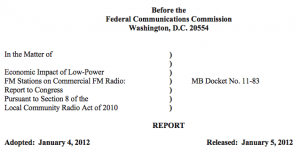Last week the FCC released its report on the economic impact of low-power FM stations on commercial radio. The report was mandated by passage of the Local Community Radio Act of 2010 (LCRA), and its primary conclusion should surprise nobody with any knowledge of LPFM: “LPFM stations are unlikely to have more than a negligible economic impact on full-service commercial FM stations.”
A pithy comment made to a post on The Hill’s technology blog sums it up even more vividly: “It sounds like a study investigating the Salvation Army thrift stores to see if they unfairly compete with Walmart.” In effect, this comment and the report make clear that the idea that LPFM could be a real threat to commercial radio is and always was a red herring tossed out by the commercial broadcast industry to try and thwart any addition to the radio dial that would not be under its own umbrella.
Of course, I’m certain there are many low-power radio advocates who wish low-power stations could be a bigger threat to the commercial radio establishment, especially given how the likes of Clear Channel decimated the medium in the wake of the Telecommunications Act of 1996. However, the ability for low-power FM to be an actual threat is mitigated by many of the same factors that blindsided the largest commercial radio companies while they were too focused on buying up stations, consolidating operations and firing staff around the turn of the century.
Nevertheless we are on the cusp of adding many more low-power community stations to the airwaves of towns and cities across the country. The stats uncovered in the Commission’s report paint an interesting portrait of LPFM that underlines both the power and limits of their reach.
With regard to the question of effect on commercial stations, the most significant face is that LPFM stations have a miniscule impact on ratings, if they show up at all. The station with the highest listenership managed to rank only 18th in its market.
The flip side of that coin is that, according to the report, amongst those stations that appear in Arbitron ratings, LPFM stations have a high value for “time spent listening” (TSL). This means that LPFM listeners tend to stay tuned in for longer periods of time. This fact leads the Commission to conclude that, “these measures suggest that the popular LPFM stations tend to attract a small but loyal fan base, which tunes in for long periods of time and/or switches stations less frequently than the average full-service station listener.”
LPFM stations are more likely to carry niche programming. So the National Association of Broadcasters told the FCC that it should consider the potential harm LPFMs would have on the small segment of commercial stations that cater to a niche audience. In particular the NAB argued that niche stations are more vulnerable due to having lower average revenues from a more typically formatted station.
However, the Commission notes that the NAB provided no examples of an LPFM that current duplicates or previously duplicated an existing commercial station’s format. The Commission cites comments filed by LPFM advocate Wesli Dymoke who contends that it is unlikely that a low-power station would choose to compete head-on with a more powerful commercial station. It also notes that the NAB provided no plausible explanation why a LPFM station would choose such a Quixotic path. In the end the FCC concludes that there is no evidence that low-power stations pose any threats to commercial stations with niche formats.
The completion of this report represents the penultimate hurdle in front of the expansion of LPFM, which it has now successfully leaped over. The final one is the outcome of the FCC’s proceeding to resolve the queue of pending applications for translator repeater stations, many of which could take up frequencies that would be suitable for new low-power stations after the LCRA. As of last June the Commission was leaning towards establishing a minimum number of LPFM-qualified frequencies that must remain available in a given market after translator applications are approved.
With luck the commissioners will resolve that proceedings in the first quarter of this year. In turn that could pave the way for a new LPFM license application window in the second or third quarter. Then it will have taken only twelve years to overcome the NAB’s attempt to cut low-power community radio off at the knees. Yet, after all that time communities of all sizes across the country still need true community radio, perhaps more than before.



